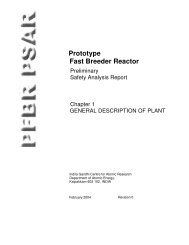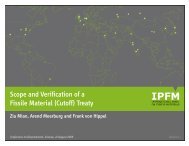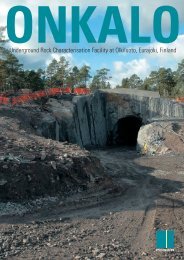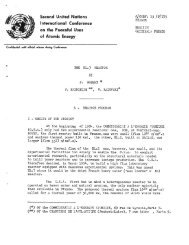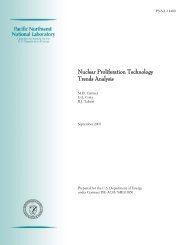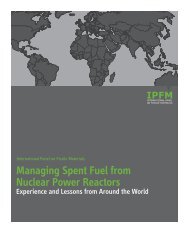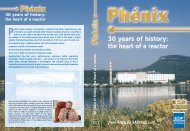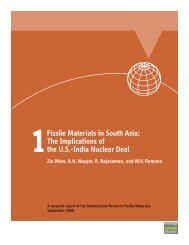Global Fissile Material Report 2009: A Path to Nuclear Disarmament
Global Fissile Material Report 2009: A Path to Nuclear Disarmament
Global Fissile Material Report 2009: A Path to Nuclear Disarmament
Create successful ePaper yourself
Turn your PDF publications into a flip-book with our unique Google optimized e-Paper software.
Appendix 3A. The U.S. Plu<strong>to</strong>nium and HEU DeclarationsThe U.S. Government’s plu<strong>to</strong>nium and highly enriched uranium (HEU) declarations(Plu<strong>to</strong>nium: The First 50 Years and Highly Enriched Uranium: Striking a Balance) outlinedthe production, acquisition, and utilization of fissile materials from the mid 1940s <strong>to</strong>the mid 1990s. 144 These declarations were constructed from records dating back <strong>to</strong> theearly 1940s and data collected regularly since the 1960s as part of the <strong>Nuclear</strong> <strong>Material</strong>sManagement and Safeguards System (NMMSS). The origin, evolution and capabilitiesof NMMSS offer insights for other nuclear weapon states wishing <strong>to</strong> consider sucha reporting system and in making such declarations for the purposes for furtheringnuclear disarmament.The U.S. Department of Energy:• Declared the <strong>to</strong>tal U.S. plu<strong>to</strong>nium and HEU inven<strong>to</strong>ries, including all materials heldby the Department of Defense in nuclear warheads, military-reac<strong>to</strong>r fuel, spent fuel,critical assemblies, and other military-use materials;• Categorized plu<strong>to</strong>nium and HEU either as "required" (i.e., in active use or plannedfuture use in either weapons or non-weapons programs) or as "surplus" <strong>to</strong> defenseneeds; and• Constructed a 50-year material balance account similar <strong>to</strong> a bank register, whichcompared an actual inven<strong>to</strong>ry against a calculated book inven<strong>to</strong>ry (based on <strong>to</strong>talacquisitions minus <strong>to</strong>tal removals).While other DOE reports had provided much of this information separately, thesedeclarations combined previously released data with newly declassified informationthat allowed the United States <strong>to</strong> issue comprehensive reports for both plu<strong>to</strong>nium andHEU.Balancing the BooksThe data for the declarations were available from at least one of three sources: (a) originalsite inven<strong>to</strong>ry and transaction journals, (b) site inven<strong>to</strong>ry and transaction dataas reported <strong>to</strong> NMMSS, and (c) his<strong>to</strong>rical material control and accounting summaryreports based on data submitted by facilities and compiled starting in the late 1940s bythe A<strong>to</strong>mic Energy Commission (AEC). The reporting units in all three data sources forboth plu<strong>to</strong>nium and HEU were grams, subsequently summarized in kilograms for thepurposes of simplifying the declarations.The material balance at each site and nationally can be expressed using the followingequation:Beginning inven<strong>to</strong>ry + receipts – shipments – measured discards or losses –ending inven<strong>to</strong>ry = material unaccountedThe production of plu<strong>to</strong>nium in a uranium-fueled reac<strong>to</strong>r is treated as a form of receipt,and the consumption (burnup) of U-235 in the same reac<strong>to</strong>r as a form of removalor measured loss. <strong>Material</strong> unaccounted (i.e., the difference between the quantity ofnuclear material held according <strong>to</strong> the accounting books and the quantity measured42 <strong>Global</strong> <strong>Fissile</strong> <strong>Material</strong> <strong>Report</strong> <strong>2009</strong>



